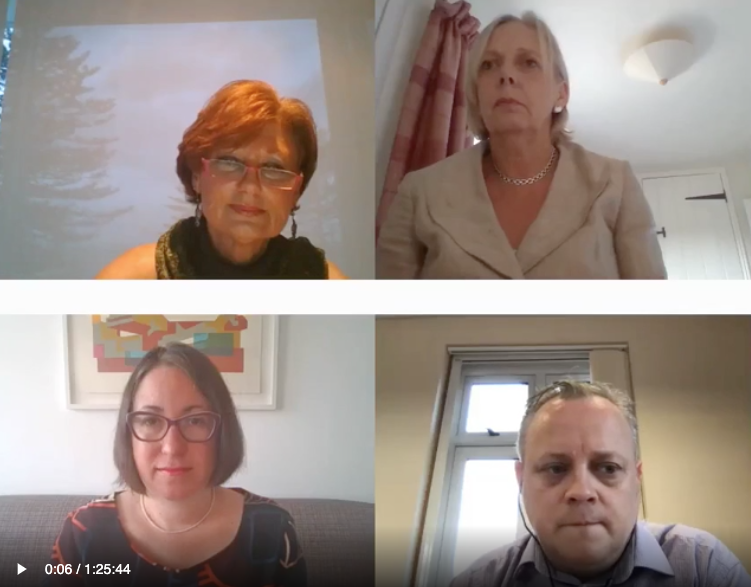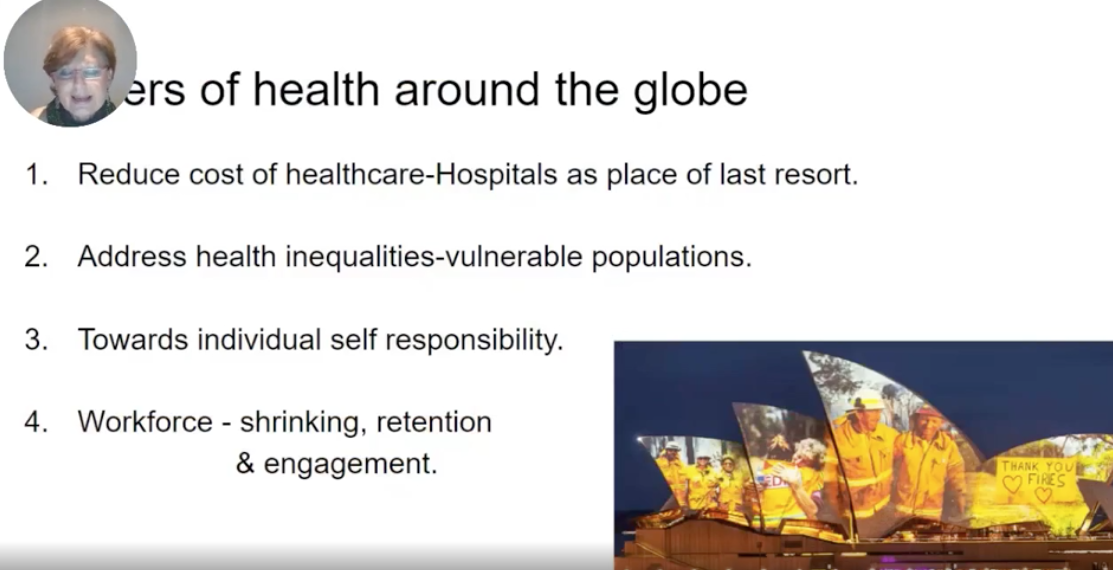Healthcare / Population health
EHD2020: COVID-19: a new paradigm – systems, science and society
By Andrew Sansom | 23 Sep 2020 | 0
This year’s 6th European Healthcare Design Congress featured a special COVID-19 Global Summit – a ‘conference within a conference’ comprising two days of talks from researchers, policy makers and practitioners from all over the world, exploring the healthcare design community’s response to the ongoing pandemic and sharing lessons learned.
The virtual Summit kicked off with keynote talks from three global health leaders who, in different capacities, have been involved in the pandemic response.
Prof Dame Anne Johnson, a professor of infectious disease epidemiology and co-director at UCL Health of the Public, provided delegates with an overview of the coronavirus, the outlook and the path ahead.
Scrutinising the high death rate in the UK, Prof Johnson highlighted that there were multiple introductions of the virus from Europe and elsewhere in February and March, although the first case may have occurred weeks or months earlier. There was also a lack of testing and sentinel surveillance, so there was a large silent epidemic going on before the magnitude of the outbreak was recognised. Other issues included the policy of discharge of infected patients from hospital to care homes, a lack of PPE for healthcare workers, the late identification of community transmission and lockdown, and the way the disease impacts different populations.
COVID-19 and hospital systems
In regard to hospital systems, Prof Johnson explained that these are not closed, and there are many possibilities within these environments for the disease to spread, such as patients to staff, staff to patients, and staff to staff. There are also issues of visitors and ambulatory patients coming into A&E; the policy of discharge of patients to care homes creating transmission issues from residents to staff; and healthcare workers using public transport to travel to work and taking the infection home.
“We now know that households are one of the most powerful environments for transmission,” she said. “ But there has been relatively little education to the public about how to reduce transmission within households.”
In regard to COVID-safe built environments, Prof Johnson emphasised all the environmental efforts that need to be put into hospitals to make them safe.
“We’ve thought a lot about making them safe for MRSA, but for these viruses that are transmitted via respiratory droplets, we need very different measures around how you manage staff spaces and hospital spaces to avoid transmission,” she said. “That needs a lot of thinking in terms of engineering, environmental cleaning, staff safety, staff education, cohorting of staff, and so on.”
With countries now experiencing a second surge of cases, Prof Johnson pointed to a modelling exercise carried out by Imperial College during the summer. Although not a prediction, this model used a reasonable worst-case scenario where the virus’ R (reproduction) value is 1.7 between September 2020 and July 2021. In this scenario, the surge would start in September, move through March and peak in January. And the total number of deaths would exceed those in the first wave. 
Prof Johnson also accentuated a report from the Academy of Medical Sciences, which came up with a number of proposals for organising health and social care during the winter months. Among the recommendations are:
- prioritising systemwide infection prevention and control measures to minimise nosocomial infection;
- adequate provision, training in, and use of PPE, and other infection prevention and control measures;
- minimising agency and multi-site staffing and staff movements between sites and hospitals;
- maximising use of remote consultations;
- cohorting staff to limit physical overlap and movement between zones;
- stratifying healthcare settings/zones into ‘hot’ and ‘cold’ areas, through the use of Nightingale hospitals and private healthcare settings; and
- establishing services to support rehabilitation of patients with post COVID-19 conditions.
Concluded Prof Johnson: “The whole issues of healthcare management, healthcare systems, healthcare design and the technologies that accompany those are hugely important.”
A global race to respond and recover
Providing a more international perspective was Dr Layla McCay, director of international relations from the NHS Confederation. She explained how the UK, alongside many other countries and healthcare systems, is in the process of doing four things: one, working to reduce the transmission of the virus; two, working to restore non-COVID health services; three, managing the current cases of COVID-19 and maintaining capacity so that health systems are ready if there is a future surge, as well as dealing with other many challenges such as winter, and for the UK this year, coping with any Brexit-related disruptions; and four, reflecting on what went well, what went less well, and how healthcare systems can emerge stronger.
She added that there is a need to learn from phase one and retain an open mindedness to change; carry on investing and innovating in evidence-based technology; and put people at the heart of the response. And the lessons that need to be learned also have to be global.
On the point about investing and innovating in evidence-based technology, remote consultations have allowed thousands of patients to stay at home and get the healthcare that they need.
Said Dr McCay: “At the start of this year, 3 per cent of primary care practices were able to offer video consultations; it’s now 99 per cent. That’s a scale of change that is unprecedented. In other times, it could have taken more than a decade. The next challenge for NHS and other health systems is to embed this innovation.
“It’s amazing but, in some cases, it would have been better if there had been more scrutiny from experts to ensure and enable better governance and interoperability, as well as proper cyber security. In dealing with the imminent threat of the second wave, we need to be looking at where we can leverage digital solutions to build capacity into test and trace systems to stop coronavirus outbreaks as quickly as possible.”
Offering some international examples, she mentioned how two German university hospitals are piloting a computer-based early warning system for infections and suspicious cases through a smart infection control system. Another example is how Singapore has used digital systems to register every healthcare visitor to reduce the possibility of spread, and ensure places of care do not turn into transmission hotspots.
And in China, hospitals have deployed AI-powered CT imaging into interpretation tools. According to Dr McCay, that has helped to reduce CT scan reading time from hours to seconds, while other tools have enabled patients at community clinics to have their scans read by medical experts miles away.
There are other issues to consider along the way in regard to innovation, including the human perspective, digital access and inclusion, and regulation, particularly around data and privacy. And in the global context, the importance of interdependence and collaboration should not be underestimated.
“COVID-19 has become a moment for change, where old habits have been disrupted and new ways of working have been embraced,” said Dr McCay. “The support for our health service has never been higher, the focus has never been so keen, and the lessons have never been so starkly laid out in terms of morbidity and mortality rates around the world.
“The next steps need to be a joint effort as the whole world fights a common enemy. Defeating COVID somewhere means defeating COVID everywhere and that means working together.”
A population health-based approach in Australia
Concluding this session, Dr Liz Paslawsky, a CEO and executive coach in integrative leadership, and a visiting professor of the Ukranian Catholic University, offered some insights into how COVID-19 has created a “golden opportunity for change” in respect of moving towards wellness-creating environments within a new population health model.
“What COVID has done is that everyone is working so closely together, there is a new understanding of each other’s capabilities,” she said. “What are the barriers we need to overcome to continue that breakdown so that the integrated patient-focused approach continues?”
Dr Paslawsky went on to focus on several aspects of population health and wellness, and look at how strategies have changed since COVID-19. One important element is caring for the vulnerable and the aged care home sector. Prior to the pandemic, there had been a deskilling of the workforce and it was rare to have good access to registered nurses. Since the pandemic, however, the strategy has been to treat in place of residence by qualified health professionals. But Dr Paslawsky predicted a whole new building industry would emerge owing to concerns about the spread of COVID-19 in nursing homes, and the ‘age in place’ healthcare model would likely evolve in response.
In responding to rising demand for mental health support, the Australian Government funded multiple providers online and phone service to support everyone from the worried well to the severely ill, but the consequence has been increased entry points into the public system. “We need to work out in the future, how do we reduce the duplication and improve co-ordination between different service providers? And how do we take the acute load off the public sector?” said Dr Paslawsky.
 COVID-19 has also impacted the strategy around individual self-responsibility. According to Dr Paslawsky, before the pandemic, self-responsibility focused on specific disease strategies around early intervention.
COVID-19 has also impacted the strategy around individual self-responsibility. According to Dr Paslawsky, before the pandemic, self-responsibility focused on specific disease strategies around early intervention.
“Hand washing, social distancing, and education around wearing masks have helped extend self-responsibility,” she said. “How can we extend it as a way of life and not an objective for specific disease types.”
And staff retention and engagement have also seen new strategies emerge following COVID-19. As well as providing increased mental health support for staff, healthcare providers have increased collaboration between traditional professional silos by reskilling health staff.
“There is a need to continue recognising their personal needs, enhance ability to move between departments, institutions and services, and take pressure off hospital system to enhance staff retention,” explained Dr Paslawsky.
What this means for the future of population health is a new focus on wellness-creating environments, she argued. And it’s not about building wellness centres but about wellness as a way of life in all sectors – physical, mental and social wellness. There is a need, too, to see health as a cross-sector collaborative and co-creative initiative.
“We’ve achieved a framework for addressing the WHO Impact Determinants of Health,” she added. “For the first time in our history, we’ve got the framework. That’s extremely powerful.”
The pandemic has also shone a spotlight on the importance of access to nature as a key strategy for wellness. And Dr Paslawsky suggested that, just as there are environmental impact assessments when new projects are considered, there could be a need for wellness impact assessments to consider the impact of a project on physical, mental and social wellness.
And bringing the discussion back to the interface between digital technology and human experience, she promoted the concept of a digital interagency health library. Aimed at empowering people in their own health decision-making through access to knowledge, skills and resources, the concept would also take account of personalisation issues around cultural background, life stage, etc. But, she added, the interagency hub would also need a librarian – a primary health person who asks the right question to start the inquiry.
In summary, Dr Paslawsky underlined that owing to the pandemic, there is a number of drivers in place to bring about successful change in health and health systems. Notably, she said, it has harnessed a degree of political will and an appreciation that wellness is a prerequisite to economic growth. She added, too, that COVID has provided the experience of implementing new models of care, and an opportunity to learn and understand the risk factors associated such change. And there is a universality that every segment of society can understand why decisions are being reached.
“Whatever your discipline, let’s continue to build the bridges towards wellness creating environments,” she concluded.
This keynote session was kindly supported by Graham.


